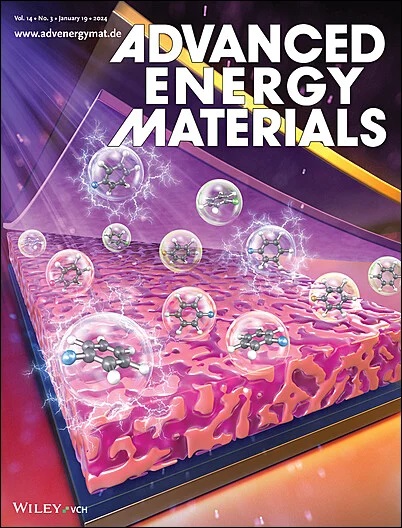Unveiling the Role of Single Atomic Ruthenium Decorated Cactus-Like Bimetallic Phosphides for Alkaline Water Electrolysis
IF 24.4
1区 材料科学
Q1 CHEMISTRY, PHYSICAL
引用次数: 0
Abstract
High-performance water-splitting electrocatalysts are pivotal for green hydrogen production. The bimetallic phosphide (NiCoP), as a promising candidate for alkaline water electrolysis, still faces challenges including sluggish reaction kinetics and instability. Herein, Ru single atoms (SAs) are anchored on cactus-like NiCoP-coated Ni foam (Ru SAs@NiCoP/NF) as a robust bifunctional catalyst for alkaline water electrolysis. Atomic dispersion of Ru via P-rich coordination induces electron redistribution, optimizing d-band centers of Ni/Co sites to reduce energy barriers for water dissociation and O2 desorption. For the hydrogen evolution reaction (HER), Ru synergistically enhances water activation and optimizes the HER process, yielding ultralow overpotentials of 8 and 240 mV at current densities of 10 and 500 mA cm−2. For the oxygen evolution reaction (OER), Ru promotes phosphorus leaching and surface reconstruction, adjusting the adsorption–desorption of intermediates in the lattice oxygen mechanism, achieving 375 mV overpotential at 1.0 A cm−2. Remarkably, the anion exchange membrane water electrolyzer using the Ru SAs@NiCoP/NF bifunctional catalysts carries only a cell voltage of 1.76 V at 0.5 A cm−2 at 80 °C for overall water splitting and long-term stability. This work reveals the critical role of single atom-supports synergy in optimizing the electronic structure and enhancing the electrocatalytic performances for high-current-density water electrolysis catalysts.

揭示单原子钌修饰仙人掌状双金属磷化物在碱水电解中的作用
高性能的水分解电催化剂是绿色制氢的关键。双金属磷化物(NiCoP)作为一种很有前途的碱水电解材料,目前还面临着反应动力学缓慢和不稳定性等挑战。本文将Ru单原子(SAs)固定在仙人掌状nicop涂层的Ni泡沫(Ru SAs@NiCoP/NF)上,作为碱性电解水的强大双功能催化剂。Ru通过富p配位的原子分散诱导电子重分布,优化了Ni/Co位的d带中心,降低了水解离和O2脱附的能量障碍。对于析氢反应(HER), Ru协同增强水活化并优化HER过程,在电流密度为10和500 mA cm−2时产生8和240 mV的超低过电位。对于析氧反应(OER), Ru促进了磷的浸出和表面重构,调节了晶格氧机制中中间体的吸附-解吸,在1.0 A cm−2下实现了375 mV的过电位。值得注意的是,使用Ru SAs@NiCoP/NF双功能催化剂的阴离子交换膜水电解槽在80°C下,在0.5 a cm−2下仅携带1.76 V的电池电压,以实现整体的水分解和长期稳定性。本研究揭示了单原子支持协同作用在优化高电流密度水电解催化剂的电子结构和提高电催化性能方面的关键作用。
本文章由计算机程序翻译,如有差异,请以英文原文为准。
求助全文
约1分钟内获得全文
求助全文
来源期刊

Advanced Energy Materials
CHEMISTRY, PHYSICAL-ENERGY & FUELS
CiteScore
41.90
自引率
4.00%
发文量
889
审稿时长
1.4 months
期刊介绍:
Established in 2011, Advanced Energy Materials is an international, interdisciplinary, English-language journal that focuses on materials used in energy harvesting, conversion, and storage. It is regarded as a top-quality journal alongside Advanced Materials, Advanced Functional Materials, and Small.
With a 2022 Impact Factor of 27.8, Advanced Energy Materials is considered a prime source for the best energy-related research. The journal covers a wide range of topics in energy-related research, including organic and inorganic photovoltaics, batteries and supercapacitors, fuel cells, hydrogen generation and storage, thermoelectrics, water splitting and photocatalysis, solar fuels and thermosolar power, magnetocalorics, and piezoelectronics.
The readership of Advanced Energy Materials includes materials scientists, chemists, physicists, and engineers in both academia and industry. The journal is indexed in various databases and collections, such as Advanced Technologies & Aerospace Database, FIZ Karlsruhe, INSPEC (IET), Science Citation Index Expanded, Technology Collection, and Web of Science, among others.
 求助内容:
求助内容: 应助结果提醒方式:
应助结果提醒方式:


